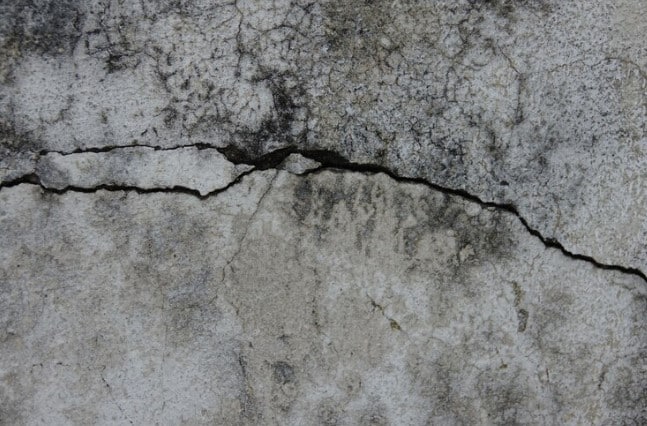Contents
A common issue in homes, foundation cracks are more than just superficial defects. They are indicators of underlying structural conditions. These cracks manifest in various forms, each telling a different story about the building’s foundation. The causes of foundation cracks are diverse.
They stem from factors like:
- Natural settlement of the structure;
- Environmental influences;
- Construction-related issues.
As we found different types of foundation cracks, including hairline, horizontal, and stair-step, we gain insights into their potential bad impact and the necessary steps for repair and prevention. This knowledge is essential for maintaining the integrity and safety of our homes.

Horizontal Foundation Cracks
Often discovered in basement walls, these cracks are significant indicators of structural problems. They primarily occur due to hydrostatic pressure — a force exerted by water-saturated soil pushing against the foundation. This pressure can be intense, especially after prolonged rainfall or flooding, creating a scenario where your foundation wall acts as a dam under stress.
Causes
- Excessive moisture from heavy rainfall or flooding;
- Inadequate drainage around the foundation;
- The freeze-thaw cycle, prevalent in colder climates.
Repair options
- Installation of interior or exterior drainage systems to mitigate hydrostatic pressure;
- Wall reinforcement using methods like epoxy injection, carbon fiber straps, or steel I-beams;
- Utilizing wall anchors or push piers to provide additional structural support and prevent further deformation.
These cracks aren’t just aesthetically displeasing; they’re harbingers of potential disaster. If left unchecked, they can lead to bowing walls, a phenomenon where once straight walls begin to curve or bulge. More alarmingly, they can allow water to seep into the basement, escalating the damage and introducing new issues like mold and dampness.
Vertical Foundation Cracks
This type of foundation cracks, while often less severe, can still pose risks if they expand beyond the typical 1/8 inch width. Such expansion can lead to moisture problems in the basement, as water finds its way through these widened gaps. It’s essential to monitor these cracks for any changes in size or appearance, as they can be early indicators of more serious structural issues.
Causes
- The natural settling process of a house or building, especially common in newer constructions;
- The concrete curing process, which can lead to shrinkage and, subsequently, cracking.
Repair options
- Regular inspections to catch any early signs of widening or lengthening;
- Sealing small cracks with appropriate materials like epoxy or polyurethane;
- For larger cracks, professional assessment and repair are advised to ensure structural integrity.
Small cracks can often be managed effectively with sealing materials such as epoxy or polyurethane. However, when faced with larger, more ominous cracks, seeking professional assessment and repair is not just advisable, but essential to maintain the structural integrity and longevity of the building. This proactive and informed approach ensures that what starts as a small crack does not escalate into a significant structural concern.
Hairline Foundation Cracks
These cracks are the most common and usually the least concerning. These thin, almost invisible cracks typically appear soon after construction, as the concrete dries and undergoes the curing process. Although they may seem inconsequential, it’s important to keep an eye on them to ensure they don’t widen or deepen.
Causes
- The drying and shrinking of concrete or mortar during the curing process;
- Minor shifts in the foundation or temperature fluctuations, which can cause slight movements in the building materials.
Repair options
- Minor hairline cracks can often be addressed with simple waterproofing sealants to prevent moisture intrusion;
- If these cracks widen or show signs of worsening, more substantial methods like epoxy or polyurethane injections might be necessary.
For the most part, these hairline cracks can be effectively managed with basic maintenance techniques, such as applying waterproofing sealants. This approach is usually sufficient to ward off moisture and protect the integrity of the foundation.
However, if these cracks begin to expand or show any signs of deterioration, more robust intervention may be required. In such cases, employing repair methods like epoxy or polyurethane injections can provide a stronger, more lasting solution.
Stair Step Foundation Cracks
They are particularly common in brick or block foundation walls and can indicate serious structural issues. These cracks follow a zigzag pattern, resembling steps, and are often found at the mortar joints of the blocks.
They can be caused by differential settling, where different parts of the foundation sink at different rates, or by excessive soil pressure against the wall.
Causes
- Moisture accumulation leading to increased soil pressure against the foundation;
- Uneven or differential settling of the foundation, often due to variations in soil conditions or moisture levels.

Repair options
- Repointing or repairing the affected mortar joints to maintain structural integrity;
- Applying a waterproofing compound to prevent further moisture intrusion;
- In cases of significant differential settling, structural reinforcement or underpinning with piers may be required to stabilize the foundation.
Addressing these cracks involves a multifaceted approach. According to a reputable company in Toronto, repointing or repairing mortar joints is essential for maintaining the wall’s structural integrity. Additionally, applying a waterproofing compound can be an effective preventative measure against further moisture-related damage.
Diagonal Foundation Cracks
Often appearing at a 30-degree angle, they are a cause for concern, particularly if they display significant variation in width. These cracks typically suggest some form of foundation movement or instability. They are a warning sign of potential structural issues, especially in block foundation walls.
Causes
- Natural settling of the foundation, leading to shifts in the structure;
- Changes in soil pressure, possibly due to moisture fluctuations or other environmental factors;
- Seismic activity or other ground movement that can cause the foundation to shift.
Repair options
- Close monitoring to track changes in the size or shape of the crack;
- Epoxy injections or carbon fiber reinforcements for minor to moderate cracks;
- In cases of significant foundation movement, installation of piers or other structural supports might be necessary to stabilize the foundation and prevent further damage.
These cracks, particularly concerning block foundation walls, require careful attention and immediate action. Their variation in width and the rate at which they change can provide critical clues about the underlying structural issues.
The causes of these cracks are varied, ranging from the natural settling of the foundation to external factors like changes in soil pressure due to environmental conditions, or even seismic activities. Each of these factors can contribute to the shifting and instability of the foundation, leading to these diagonal cracks.
Conclusion
Understanding the nature of different foundation cracks and responding appropriately is vital in safeguarding the building against the slow but significant threats posed by foundation damage. Homeowners and property managers should view these cracks not just as a problem to be fixed, but as an opportunity to enhance the durability and safety of their homes and buildings.
Foundation Cracks FAQ
-
What is the best way to repair cracks in buildings to prevent serious structural problems?
Small cracks can be repaired with sealant materials to prevent serious structural problems, while large cracks can only be repaired by professionals.
-
Are there any factors that can lead to foundation problems?
If you do not make sure that moisture does not accumulate, this will lead to subsidence, which will cause more problems.
-
What repair methods should I use for hairline cracks?
You may try such methods as epoxy or polyurethane injections.
-
Why are foundation cracks wider than 1/8-inch a danger?
Cracks of this size can lead to moisture problems in the basement, which will eventually lead to even more significant issues, namely mould and horrible smell.
